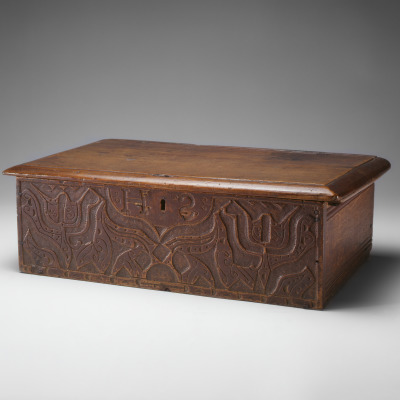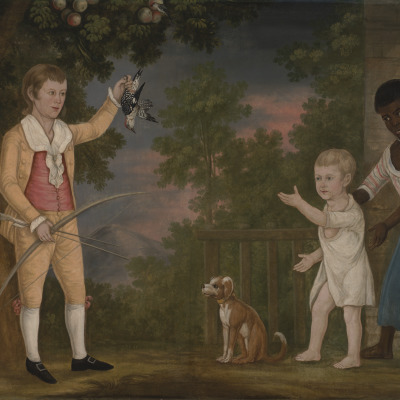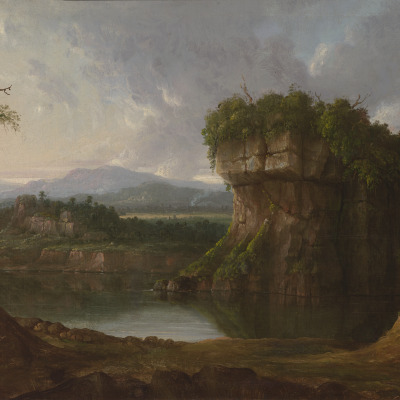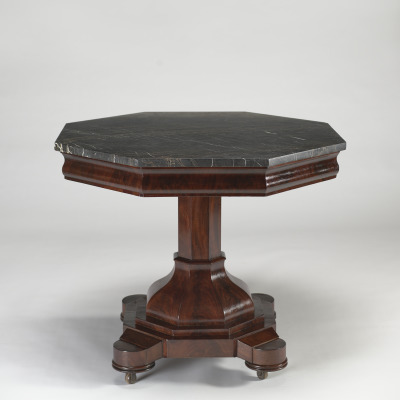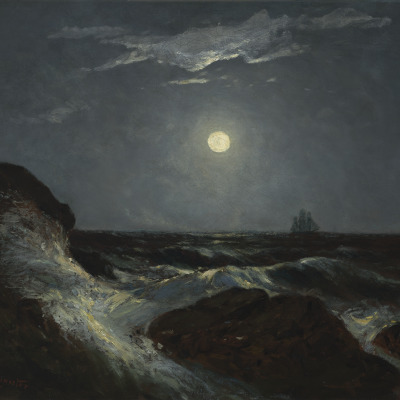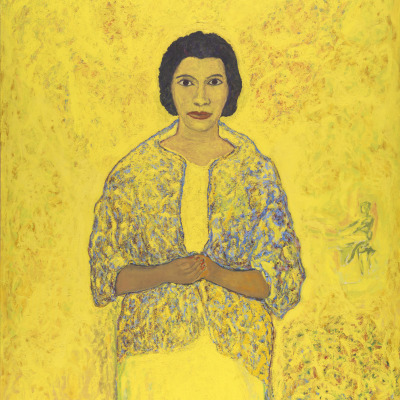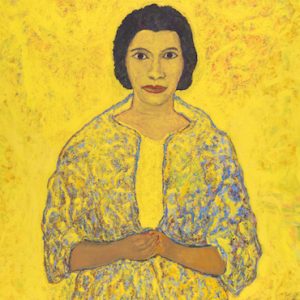
African American Dreams
This art-based adventure explores the African American experience in North America by pairing visual and written primary sources. The works of art have been chosen from the American Art collection at the Virginia Museum of Fine Arts. The written selections include poems, speeches, and other historical documents. Combining images with words provides students with multiple learning pathways for explorations of art, history, and language.
Introduction
What is a primary source?
A primary source is something written, created, or recorded at the time of a period being studied or considered. Primary sources can include documents, poems, essays, works of art, and artifacts. Primary sources provide evidence of what the people who lived in a particular time thought and wrote about the world around them, which in turn helps us understand historical developments. Of course, secondary sources can be important as well!
What is a secondary source?
A secondary source is a work that is based on various primary sources. It organizes and interprets information to help form understandings of the past. Examples of secondary sources include textbooks, encyclopedias, histories, essays, and other writings that bring together, analyze, and interpret information about the past.
Why do we keep returning to primary sources when we have secondary sources?
Re-examinations of primary sources make it possible for each generation to reconsider what earlier generations have written about the past. For example, many early history texts focused mainly on politics, economics, and war, without including other kinds of social history. Many aspects of our interpretation of the past changed once historians began to incorporate information such as accounts of daily life, works of art, artifacts, and other types of data in their consideration of past eras.
Colonial & Revolutionary Periods, 1685–1789

Document Box, American (New England), ca. 1685–1720, Artist unknown, Oak and pine,
The Mary Morton Parsons Fund forAmerican Decorative Arts
This document box features hand-carved tulips, which was a popular motif in Elizabethan England. Traces of the original reddish brown paint can still be seen on the surface of this early colonial document box.
The adventurers who came to the new English colonies voluntarily were in search of new opportunities. They dreamed of acquiring wealth, property, and land—or perhaps of practicing a particular kind of religion. This box might have held a family Bible, birth records, wills and testaments, and other documents that were connected with the dream of building a better life in the Americas.
Most of the Africans who arrived in the Americas in the colonial era came because they had been kidnapped and sold into slavery. Their dreams must have been very different from those of those early colonists who came seeking opportunities.
Reading Selection
In late August 1619, the first Africans to arrive in the English colony of Virginia landed at Jamestown. Their arrival is described in the primary source passage that follows, which was written by colonist John Rolfe. You will notice that spelling had not yet been standardized.
Selection from John Rolfe’s letter to Sir Edwin Sandys, Treasurer of the Virginia Company of London, January 1620.
“About the letter end of August, a Dutch man of Warr of the burden of a 160 tunes arrived at Point-Comfort, the Comandors name Capt Jope, his Pilott for the West Indies one Mr Marmaduke an Englishman. They mett with the Trer [The Treasurer—another ship] in the West Indyes, and determyned to hold consort shipp hitherward [to sail together], but in their passage lost one the other. He brought not any thing but 20. and odd Negroes, which the Governor and Cape Marchant bought for victualles (Whereof he was in greate need as he pretended) at the best and easyest rates they could. He hadd a lardge and ample comyssion from his Excellency to range and to take purchase in the West Indyes.”
The previous excerpt describes the first group of African people brought to the colony of Virginia. John Rolfe writes to Sir Edwin Sandys that these “Negroes” were brought to Virginia by a Dutch ship. Some historians assert that the Africans were forcibly taken by the Dutch from a Spanish ship. Other historians have discovered Spanish documents dated to 1619 that describe how Spanish and Portuguese ships were robbed of their enslaved cargo by British ships waving a Dutch flag. While historians are still debating the true origins of Virginia’s first African inhabitants, it is clear that primary sources can’t always be fully trusted. It’s likely that John Rolfe wasn’t revealing the whole truth to Sir Edwin Sandys.
Historians are also still investigating the ultimate status of these Africans. They may have become indentured servants, but by 1662, the House of Burgesses passed legislation establishing that a child’s status—free or enslaved—was determined by the status of the mother. Tobacco production in the Virginia colonies soon came to rely on enslaved workers. By 1700, at least 20 percent of Virginia’s population of African descent was enslaved.
Early Republic & Jacksonian Periods, 1790s–1830s
This painting features two sons of the Virginia planter Archer Payne and his wife, Martha Dandridge Payne. Archer Payne was the master of New Market, a large plantation located in Goochland County, just west of Richmond. At the time the painting was made, Payne was a successful man of property who owned a two-story manor house, over a thousand acres of productive farm land, and about two dozen enslaved laborers. The young man holding the bow and arrows in his right hand and a woodpecker in his left is eleven-year-old Alexander Spotswood Payne, who eventually inherited his father’s plantation. He is greeted by his younger brother, John Robert Dandridge Payne, and the family dog.
On the far right of the painting, a young African American girl leans forward, ready to support the toddler, who is still wearing his linen infant shirt. She is dressed in a jacket and petticoat, the typical outfit of an enslaved plantation house servant. Although the painter was likely representing a particular person, the girl’s presence in the painting symbolized the family’s prosperity. She appears to be about the same height as Alexander, so she is probably also around eleven—but she is already serving as the family nursemaid.
This painting was created around 1790 or 1791, just a few years after the American Revolution, which took place from 1765 to 1783. Even though this revolution was inspired by ideas such as liberty and freedom, the new United States ratified a constitution that extended the slave trade for another twenty years. In fact, when the U.S. Constitution was put into force in 1789, the number of each state’s congressmen in the House of Representatives was based on population and the constitution allowed each enslaved man, woman, and child to be counted as threefifths of a human being.
We don’t even know the name of this enslaved nursemaid—although scholars continue to examine surviving records and artifacts looking for clues to her identity and her life story. Let’s turn our attention to another young enslaved girl whose poetry sheds light on this early era in American history.
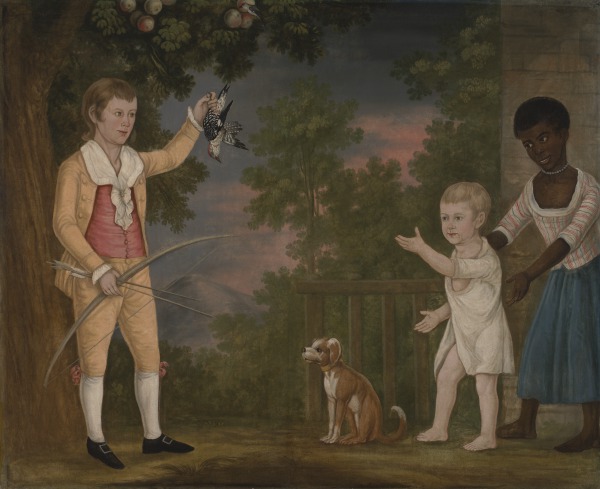
Alexander Spotswood Payne and His Brother, John Robert Dandridge Payne, with Their Nurse, American, ca. 1790–1791,
Unknown artist, called the Payne Limner,
Oil on canvas,
Gift of Miss Dorothy Payne
Reading Selection
Phillis Wheatley was an African-born American poet who is celebrated as the first widely known African American writer in America. By the time the Payne portrait was made, she had already become a famous, published poet. She arrived in Boston in 1761 aboard the slave ship Phillis, from which her first name was taken. She was bought as a slave by John Wheatley, a Boston businessman, for his wife who was in need of a house servant. As was common in that era, she took her new owner’s last name—and so became Phillis Wheatley.
A collection of thirty-nine of Phillis Wheatley’s verses called Poems on Various Subjects was published in England in 1773. Her book sold well both in England and in America, with eleven editions printed between 1773 and 1838. In the decades that followed, Phillis Wheatley’s literary accomplishments were often used to disprove one of the main justifications for slavery in America—the claim that Africans were intellectually inferior to Europeans.
Excerpt from Phillis Wheatley’s poem On Imagination
Imagination! who can sing thy force?
Or who describe the swiftness of thy course?
Soaring through air to find the bright abode,
Th’ empyreal palace of the thund’ring God,
We on thy pinions can surpass the wind,
And leave the rolling universe behind:
From star to star the mental optics rove,
Measure the skies, and range the realms above.
There in one view we grasp the mighty whole,
Or with new worlds amaze th’ unbounded soul
Antebellum Era, 1830s–1861
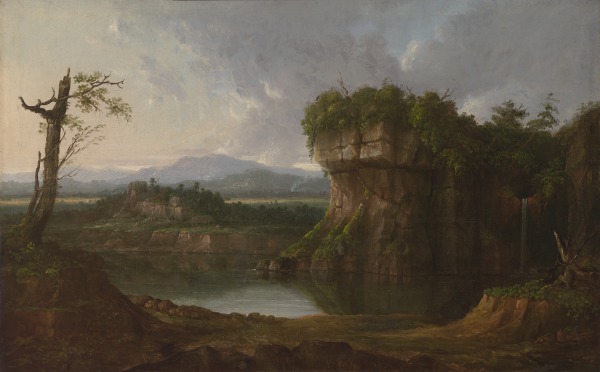
The Quarry, ca. 1855-63,
Robert Seldon Duncanson,
American (1821–1872), Oil on canvas,
Gift of the Council of the Virginia Museum of Fine Arts, in Commemoration of its Fiftieth Anniversary
Duncanson was a free African American who established an international reputation during the tumultuous decades surrounding the Civil War. Although his mother and grandfather were once enslaved in Virginia, he was born in rural New York. His early years were spent in Monroe, Michigan, where he learned carpentry, glazing, and house painting skills from his father. As a teenager, he continued the family trade by painting and decorating houses, but his dream was to become a renowned painter. He was soon working toward this goal by drawing still lifes and portraits, and copying prints.
In the 1840s, he moved to a small town near Cincinnati in the Ohio River Valley. There he received commissions for portraits and began to paint landscapes, attracting the notice and friendship of several leading Ohio Valley landscapists. With financial support from Nicholas Longworth, a Cincinnati philanthropist and abolitionist who admired his work, Duncanson was able to enjoy a European tour in 1853. His paintings were attracting attention in national exhibitions by 1861—as evidenced by the following accolade in the Cincinnati Gazette: “Mr. Duncanson has long enjoyed the enviable reputation of being the best landscape painter in the West.”
After spending the war years in Canada, Duncanson visited Great Britain where he enjoyed the enthusiastic patronage of many British notables and aristocrats. He returned to the United State in 1866. Although he continued to enjoy success in his career, he was certainly conscious of the racial tensions that followed the Civil War. In 1871, he suffered a complete mental breakdown, possibly caused by his early exposure to the lead in house paints, and died at the early age of fifty-one in 1872.
Reading Selection
Just three years before Duncanson’s birth, another African American who dreamed of a different world for enslaved Americans was born into slavery in Talbot County, Maryland. His name was Frederick Douglass—and he became one of the most famous social reformers of his day. After escaping from slavery in 1838, he became an influential lecturer and abolitionist in the North and abroad. His major works include Narrative of the Life of Frederick Douglass, an American Slave (1845) and The Life and Times of Frederick Douglass (1881). He also cofounded and edited North Star, an abolitionist newspaper. This excerpt from a speech he gave in 1857 makes it clear that his dream was to achieve freedom for all.
From “If There Is No Struggle, There Is No Progress,” a speech delivered in 1857 by Frederick Douglass (ca. February 1818–1895)
“The general sentiment of mankind is that a man who will not fight for himself, when he has the means of doing so, is not worth being fought for by others, and this sentiment is just. For a man who does not value freedom for himself will never value it for others, or put himself to any inconvenience to gain it for others. Such a man, the world says, may lie down until he has sense enough to stand up. It is useless and cruel to put a man on his legs, if the next moment his head is to be brought against a curbstone. . . . Let me give you a word of the philosophy of reform. The whole history of the progress of human liberty shows that all concessions yet made to her august claims have been born of earnest struggle. The conflict has been exciting, agitating, all-absorbing, and for the time being, putting all other tumults to silence. It must do this or it does nothing. If there is no struggle there is no progress. Those who profess to favor freedom and yet deprecate agitation are men who want crops without plowing up the ground; they want rain without thunder and lightning. They want the ocean without the awful roar of its many waters.”
Civil War & Centennial Eras, 1860s–1870s
This robust center table is attributed to the shop of Thomas Day, the celebrated African American cabinetmaker who owned one of the most successful furniture manufactories in the antebellum South.
Day was born in 1801 in Dinwiddie, Virginia, to free African American parents. He and his brother John Day, Jr., who later moved to Liberia and became a Baptist minister, were well educated, attending school with white students in Sussex County. Day learned carpentry skills from his father before relocating to Milton, North Carolina. By 1850, his shop had become the state’s largest cabinetmaking firm, operating with the latest steam-driven technology. Day’s predominantly white clientele included affluent planters, businessmen, and politicians from several states. He also produced architectural ornamentation for the interiors of churches, schools, and residences.
Day’s economic and social position was unique. He was a free African American who owned slaves. Some historians believe that he was merely staying competitive by following a normal business practice. Others argue that Day purchased slaves (as many whites and free African Americans did) to keep families together—with the ultimate intention of granting their freedom. Eventually, however, Day’s business suffered financial setbacks, perhaps due to the increasing restrictions on the rights of free African Americans. He died in 1861.
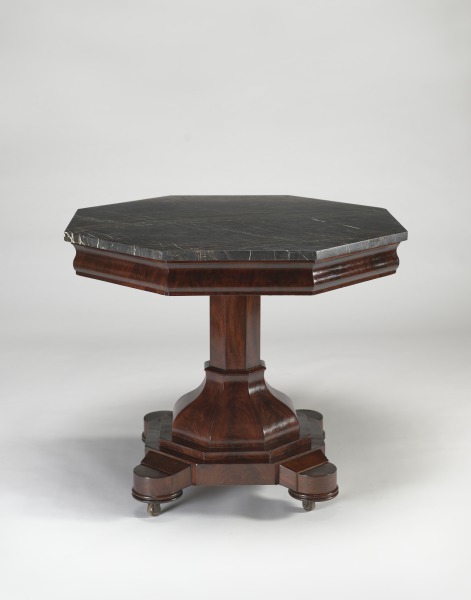
Center Table, 1850s,
Attributed to Thomas Day, American (1801–1861),
Mahogany veneer, tulip poplar, marble top, brass casters,
Kathleen Boone Samuels Memorial Fund
Reading Selection
In 1827, Day advertised his products in the Milton Gazette & Roanoke Advertiser newspaper:
“THOMAS DAY, CABINET MAKER, Returns his thanks for the patronage he has received, and wishes to inform his friends and the public that he has on hand, and intends keeping, a handsome supply of Mahogoney, Walnut and Stained FURNITURE, the most fashionable and common BED STEADS, & which he would be glad to sell very low. All orders in his line, in Repairing, Varnishing, & will be thankfully received and punctuallo attended to.”
Although Thomas Day did not live to hear the words of the Emancipation Proclamation, it was a significant step toward the realization of freedom for all Americans. Day’s children dreamed of a better future and became prominent members of the activist free black community of Wilmington, North Carolina. This proclamation was issued by President Abraham Lincoln on January 1, 1863, during the third year of the American Civil War.
Excerpt from The Emancipation Proclamation, January 1, 1863
That on the first day of January, in the year of our Lord one thousand eight hundred and sixty-three, all persons held as slaves within any State or designated part of a State, the people whereof shall then be in rebellion against the United States, shall be then, thenceforward, and forever free; and the Executive Government of the United States, including the military and naval authority thereof, will recognize and maintain the freedom of such persons, and will do no act or acts to repress such persons, or any of them, in any efforts they may make for their actual freedom.
Gilded Age & Expatriates 1880s–1900s
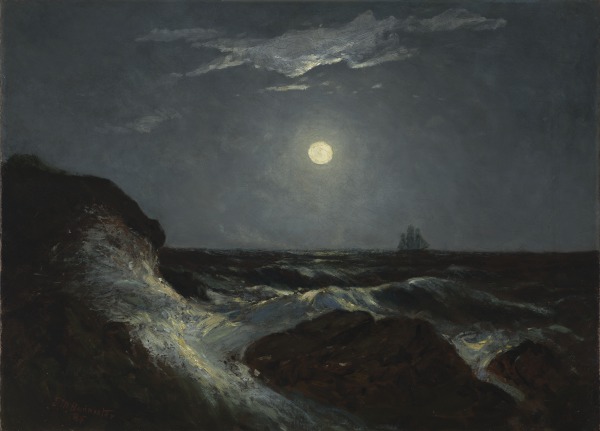
Moonlight Marine, 1885,
Edward Bannister,
American (1828–1901),
Oil on canvas,
J. Harwood and Louise B. Cochrane Fund for American Art
Painting and the sea were dual passions of Edward Mitchell Bannister, one of the first African American artists to receive widespread acclaim. In 1850 Bannister settled in Boston, Massachusetts, an important abolitionist city that provided the economic, artistic, and social opportunities required for a successful career as an artist. After working briefly as a barber, he studied sculpture at the Lowell Center. His first commissioned work, The Ship Outward Bound, produced in 1855, was likely inspired by an early job on a coastal sailing vessel.
In 1857, he married Christiana Carteaux, a Narragansett Indian from North Kingston, Rhode Island, who was working as a hairdresser and wigmaker in Boston. In 1860, the couple moved to Providence, Rhode Island. Just five years later, his painting Under the Oaks was accepted in the Philadelphia Centennial Exposition of 1876. The painting won the first-prize medal, which caused an uproar when the judges discovered that the artist was African American. The judges wanted to reconsider their choice, but at the insistence of Bannister’s white competitors, the decision stood and he received the medal.
By the decades of 1870s and 80s, Bannister was counted among the foremost painters in Providence. He invested his later marine subjects – views of the Atlantic and Rhode Island coastline—with a more experimental vision and dramatic touch. Moonlight Marine is an exceptional example of the painter’s bolder mature style. Devoutly religious throughout his life, he died in 1901 while attending a prayer meeting at the Elmwood Avenue Baptist Church in Providence.
Reading Selection
Bannister’s romantic images of the sea offer a fitting setting to the “Sorrow Songs” that are quoted by W.E.B. Du Bois in his prophetic book The Souls of Black Folks, published in 1903. Du Bois was an African American civil rights leader who cofounded the NAACP, edited the journal Crisis, and wrote numerous books, including Color and Democracy (1945), which promoted ideas of equality and justice.
Excerpt from The Souls of Black Folks, 1903, W.E.B. Du Bois (1868-1963) Chapter XIV:
The Sorrow Songs I walk through the churchyard
To lay this body down;
I know moon-rise, I know star-rise;
I walk in the moonlight, I walk in the starlight;
I ’ll lie in the grave and stretch out my arms,
I ’ll go to judgment in the evening of the day,
And my soul and thy soul shall meet that day,
When I lay this body down.
NEGRO SONG.
THEY that walked in darkness sang songs in the olden days—Sorrow Songs—for they were weary at heart. And so before each thought that I have written in this book I have set a phrase, a haunting echo of these weird old songs in which the soul of the black slave spoke to men. Ever since I was a child these songs have stirred me strangely. They came out of the South unknown to me, one by one, and yet at once I knew them as of me and of mine. Then in after years when I came to Nashville I saw the great temple builded of these songs towering over the pale city. To me Jubilee Hall seemed ever made of the songs themselves, and its bricks were red with the blood and dust of toil. Out of them rose for me morning, noon, and night, bursts of wonderful melody, full of the voices of my brothers and sisters, full of the voices of the past. Little of beauty has America given the world save the rude grandeur God himself stamped on her bosom; the human spirit in this new world has expressed itself in vigor and ingenuity rather than in beauty. And so by fateful chance the Negro folk-song—the rhythmic cry of the slave—stands to-day not simply as the sole American music, but as the most beautiful expression of human experience born this side the seas. It has been neglected, it has been, and is, half despised, and above all it has been persistently mistaken and misunderstood; but notwithstanding, it still remains as the singular spiritual heritage of the nation and the greatest gift of the Negro people.
Impressionism, Realism & Modernism 1890s–1930s
The subject of this plaster bust is Paul Laurence Dunbar (1872– 1906), the first African American to gain national distinction as an American poet. His work was produced in two distinct voices— the Standard English of the classical poet and the expressive dialect of the turn-of-the-century black community in America. Dunbar championed civil rights causes and the demand for higher education for African Americans in his essays and poetry, which were read widely by both black and white audiences across the country at the turn of the century.
Richmond Barthé, the artist, was known for sculpting African, Caribbean, and African American subjects, both free-standing full figures and portrait busts. Born in Mississippi in 1901, Richmond Barthé and his family moved to New Orleans when he was still young. He attended the Art Institute of Chicago from 1924 to 1928 while working odd jobs to support himself. In 1929, he moved to New York City, where he attracted the attention of Gertrude Vanderbilt Whitney, art patron, collector, and founder of the Whitney Museum of American Art. This connection made it possible for Barthé to exhibit work in the 1933 Whitney Museum of American Art Annual.
Barthé was considered by writers and critics as one of the leading “moderns” of his time. He once said: “. . . all my life I have been interested in trying to capture the spiritual quality I see and feel in people, and I feel that the human figure as God made it, is the best means of expressing this spirit in man.”
Barthé’s subjects ranged from straightforward, dignified genre and figure studies of African and African American people, with an emphasis on portraiture, to public works on a heroic scale. Stylized, studied movement, like those seen in dance, were often a part of his style.
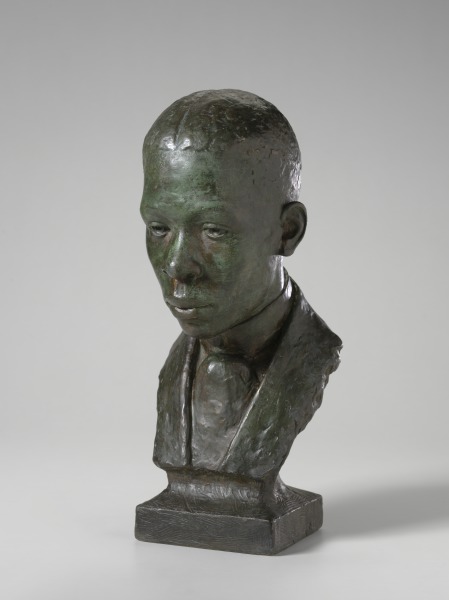
Paul Laurence Dunbar, 1928,
Richmond Barthé,
American,
Painted plaster
Reading Selection
“He Had His Dream” published in Complete Poems of Paul Laurence Dunbar, Dodd Mead & Company, 1922; first published in 1895 by The Century Co.
He had his dream, and all through life,
Worked up to it through toil and strife.
Afloat fore’er before his eyes,
It colored for him all his skies:
The storm-cloud dark Above his bark,
The calm and listless vault of blue
Took on its hopeful hue, It tinctured every passing beam –
He had his dream.
He labored hard and failed at last,
His sails too weak to bear the blast,
The raging tempests tore away And sent his beating bark astray.
But what cared he
For wind or sea! He said, “The tempest will be short,
My bark will come to port.”
He saw through every cloud a gleam –
He had his dream.
Reading Selection
Excerpts from the beginning verses of “The Prodigal Son” from God’s Trombones: Seven Negro Sermons in Verse by James Weldon Johnson (1871–1938).
Young man –
Young man –
Your arm’s too short to box with God.
But Jesus spake in a parable, and he said:
A certain man had two sons.
Jesus didn’t give this man a name,
But his name is God Almighty.
And Jesus didn’t call these sons by name,
But ev’ry young man,
Ev’rywhere,
Is one of these two sons.
And the younger son said to his father,
He said: Father, divide up the property,
And give me my portion now.
And the father with tears in his eyes said: Son,
Don’t leave your father’s house.
And haughty in his heart,
And he took his share of his father’s goods,
And went into a far-off country.
There comes a time, There comes a time
When ev’ry young man looks out from his father’s house,
Longing for that far-off country.
Interwar Years: 1930s–1950s
African American painter Beauford Delaney was a critically acclaimed artist often remembered for his symbolic use of sharp, pure colors that thickly saturated his canvases. This portrait, of iconic singer and civil rights advocate Marian Anderson, is painted in bright yellow, which Delaney used to symbolize her otherworldly perfection and grace.
Marian Anderson was an African American contralto singer who became an important symbol in the struggle to overcome racial prejudices, especially for African American artists such as Delaney. Her elevation to this role was brought about in part by a particular incident that took place in 1939.
Following a highly successful world tour in which she was hailed as one of the greatest performers of the era, she was scheduled to give a benefit performance for Howard University. It was standard practice for anyone with such an extraordinary international reputation to perform in Constitution Hall in Washington D.C., which was owned by the Daughters of the American Revolution. The DAR leadership refused to allow her to sing to an integrated audience in their venue. This refusal was a call to action to many people, including Eleanor Roosevelt, who soon thereafter resigned her membership in the DAR in protest. Through the efforts of numerous people, arrangements were made for the concert to take place in front of the Lincoln Memorial instead.
Constitution Hall would have held approximately 4,000 people. On Easter Sunday, April 9, 1939, 75,000 people turned out to hear Anderson’s performance—and hundreds of thousands more heard her over the radio. She began the concert against the backdrop of the Great Emancipator, with a rendition of My Country Tis of Thee.
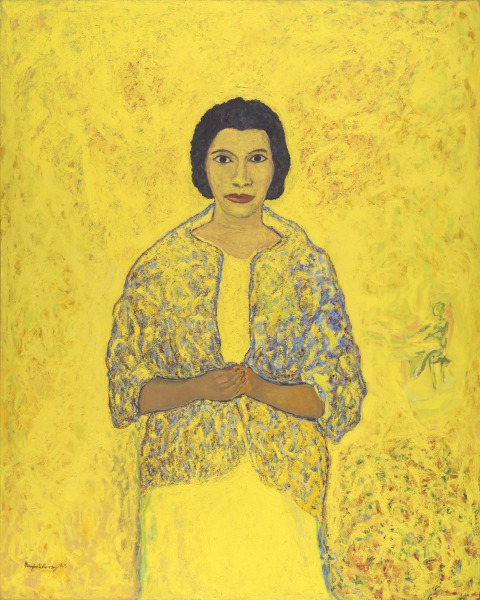
Marian Anderson, 1965,
Beauford Delaney,
American (1901–1979)
Oil on canvas,
J. Harwood and Louise B. Cochrane Fund for American Art
Beauford Delaney and Marian Anderson
In 1929, Delaney was drawn to New York by the lingering energy and ambition of the Harlem Renaissance. There he abandoned the traditional realism taught to him in his earlier artistic education for a new, more expressive style that was more in harmony with his love of musical rhythm and which used dazzling and dramatic colors.
Delaney’s first painting of Anderson, Marian Anderson, Greenwich Village, 1951, was inspired by a memorable personal meeting with the singer in the late 1940s. Delaney had taken the writer James Baldwin to hear Anderson perform in New York, and afterwards they went backstage to meet her. According to Baldwin, “On the way home Beauford could talk of nothing but Anderson’s ‘smoky yellow gown’ in relation to her ‘copper and tan’ skin and the red roses scattered about her dressing room.” Unable to capture the distinctive beauty of the singer’s voice on canvas, Delaney painted Anderson as a semi-abstract element in a vibrant composition, linking elements of color, texture, and space with the acoustical and emotional impact of her music.
Later encounters with Anderson—at a 1956 concert in Paris and a 1965 performance in SainteChapelle—may have inspired Delaney to portray her again from memory. The result was VMFA’s iconic portrait of this African American cultural hero whose artistic talent and integrity inspired a generation. In this “memory” portrait—painted in Paris but with an awareness of the Civil Rights struggle underway in America—Delaney expressed his ongoing admiration for Anderson’s sensitive brilliance as a performer and person.
Reading Selection
Beauford Delaney was not the only American to be inspired by Marian Anderson’s performance in front of the Lincoln Memorial. In 1944, a high school junior at Atlanta’s Booker T. Washington High School spoke about this inspiring incident during his speech on the topic of “The Negro and the Constitution” for an oratory contest sponsored by the black Elks. He won the contest.
Excerpt from The Negro and the Constitution, 1944, Martin Luther King, Jr.
“Black America still wears chains. The finest Negro is at the mercy of the meanest white man. Even winners of our highest honors face the class color bar. Look at a few of the paradoxes that mark daily life in America. Marian Anderson was barred from singing in the Constitution Hall, ironically enough, by the professional daughters of the very men who founded this nation for liberty and equality. But this tale had a different ending. The nation rose in protest, and gave a stunning rebuke to the Daughters of the American Revolution and a tremendous ovation to the artist, Marian Anderson, who sang in Washington on Easter Sunday and fittingly, before the Lincoln Memorial. Ranking cabinet members and a justice of the Supreme Court were seated about her. Seventy-five thousand people stood patiently for hours to hear a great artist at a historic moment. She sang as never before with tears in her eyes. When the words of “America” and “Nobody Knows De Trouble I Seen” rang out over that great gathering, there was a hush on the sea of uplifted faces, black and white, and a new baptism of liberty, equality and fraternity. That was a touching tribute, but Miss Anderson may not as yet spend the night in any good hotel in America. Recently she was again signally honored by being given the Bok reward as the most distinguished resident of Philadelphia. Yet she cannot be served in many of the public restaurants of her home city, even after it has declared her to be its best citizen. . . .
My heart throbs anew in the hope that inspired by the example of Lincoln, imbued with the spirit of Christ, [America] will cast down the last barrier to perfect freedom,” said the young King. “And I with my brother of blackest hue possessing at last my rightful heritage and holding my head erect, may stand beside the Saxon–a Negro–and yet a man!”
Dialogue Prompt
Use the following discussion to begin a dialogue:
How many themes related to dreams can you find woven through the work of these artists and writers?
Can you define the dream that will inspire your life?
Selected Sources
Many of the informational passages about the works of art in this document are adapted from the catalogue of the American Art Galleries at VMFA (listed below) and from curatorial essays.
O’Leary, E. L., and S. Yount, and S. J. Rawles, and D. P. Curry, American Art at the Virginia Museum of Fine Arts. Virginia Museum of Fine Arts, Richmond, in association with University of Virginia Press, Charlottesville and London, 2010.
Phillis Wheatley
Cooper, Afua. My Name is Phillis Wheatley: A Story of Slavery and Freedom. KCP Fiction, An Imprint of Kids Can Press, 2009.
YouTube video of Allen Gregg in Conversation with Afua Cooper, author of “My Name is Phillis Wheatley”; Uploaded on Mar 1, 2010. https://www.youtube.com/watch?v=SdLPT2lr4NE#t=464
Khomina Anna. Phillis Wheatley: A Poet Enslaved and Enlightened, U.S. History Scene website, http://ushistoryscene.com/article/phillis-wheatley/, accessed 2-15-2015.
Odell, Margaretta Matilda. Memoir and Poems of Phillis Wheatley, a Native African and a Slave. Dedicated to the Friends of the Africans: Electronic Edition. (The original edition was published in Boston by Geo. W. Light, Lyceum Depository, 3 Cornhill, in 1834.) http://docsouth.unc.edu/neh/wheatley/wheatley.html
Funding from the National Foundation for the Humanities supported the electronic publication of this title. This work is the property of the University of North Carolina at Chapel Hill. It may be used freely by individuals for research, teaching and personal use as long as this statement of availability is included in the text.
Poetry Foundation website entry for Phillis Wheatley, accessed 2-14-2015 http://www.poetryfoundation.org/bio/phillis-wheatley
Sheridan, Stephanie. National Portrait Gallery, Smithsonian Institution blog: Phillis Wheatley: Her Life, Poetry, and Legacy, March 27, 2014, Catalog of American Portraits, National Portrait Gallery, accessed 2-14-2015 http://npg.si.edu/blog/phillis-wheatley-her-life-poetry-and-legacy
Robert Seldon Duncanson
Moore, Lucinda. America’s Forgotten Landscape Painter: Robert S. Duncanson. smithsonian.com, October 18, 2011 (accessed 2-16-2015) http://www.smithsonianmag.com/arts-culture/americas-forgotten-landscapepainter-robert-s-duncanson-112952174/?no-ist=&page=1
Thomas Day
Thomas Day Education Project website: http://thomasday.net/
Edward Bannister
Rhode Island College website for Bannister Gallery: http://www.ric.edu/bannister/Pages/Edward-Mitchell-Bannister.aspx
Michael Rosenfeld Art Gallery information on Bannister: http://www.michaelrosenfeldart.com/artists/edward-mitchell-bannister-1828-1901
